|
|
Show
→ summary only
→ detailed version only

In Hadara (Arabic for civilization and culture), it’s your chance to make history. Over three epochs, guide
the growth of your civilization as new ideas emerge; take great strides forward in the many fields of human
achievement to build an empire more glorious than any other. Skilled artisans, philosophers, warriors, and
architects from various cultures bring their genius to aid you in your endeavors, but it rests with you to choose
the best citizens to build your strength and prestige.
Components
1
5
162
5 Setup Cards
5 Reference Sheets
20 Wooden Markers (5 per color)
62 Coins
40 Bonus Tiles (10 per color)
48 10-value Markers
25 Colonies
10 Gold Medals
1 Score pad
1 Rulebook
Communal Setup
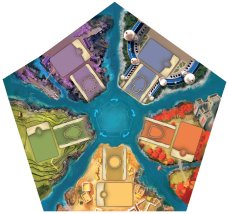
1
Connect the 5 segments of the board together in any order and place the board in the middle of the table.
2
 Separate the epoch cards based on the number on the card backs (I, II, or III),
then set aside the era II and III cards. Separate the epoch I cards into 5 decks by color, shuffle
each deck, then place 2 cards of each color per player facedown on the
corresponding inner spaces of the board. Return the remaining epoch I cards to the box.
Separate the epoch cards based on the number on the card backs (I, II, or III),
then set aside the era II and III cards. Separate the epoch I cards into 5 decks by color, shuffle
each deck, then place 2 cards of each color per player facedown on the
corresponding inner spaces of the board. Return the remaining epoch I cards to the box.
Whenever a rule refers to “cards,” it refers to epoch cards, unless otherwise noted.
 For the basic game, return the purple cards with stars at the bottom of the card to the box. These cards are used for the advanced game.
For the basic game, return the purple cards with stars at the bottom of the card to the box. These cards are used for the advanced game.
3
Separate the 25 colonies by the values shown in the bottom-left ( ),
shuffle the 5 piles separately,
then place 1 colony per player from each pile next to the board. Place each colony with the ),
shuffle the 5 piles separately,
then place 1 colony per player from each pile next to the board. Place each colony with the
 side showing coins faceup, in a stack with the other colonies showing the same value, without
looking at the reverse side. Return any remaining colonies to the box without looking at them.
side showing coins faceup, in a stack with the other colonies showing the same value, without
looking at the reverse side. Return any remaining colonies to the box without looking at them.
4
Place the coins  and
the 10-value markers and
the 10-value markers  next to the game board. There
are coins in denominations of 1,
5 and 10. You can make change
at any time, and coins are not
component-limited.
next to the game board. There
are coins in denominations of 1,
5 and 10. You can make change
at any time, and coins are not
component-limited.
Set aside the score pad.
Player Setup
Anatomy of a setup card
|
BCoins
Gain coins from the supply equal to the value on your setup
card. This setup card gives you 8 coins.
|
|
|
AInitiative Value
Initiative determines
who will be the first
player during the game.
This setup card gives you
an initiative of 2.
|
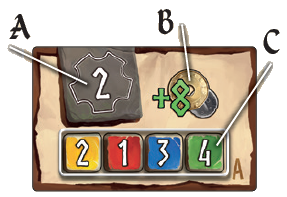 |
CTrack Values
There are 4 tracks in the game: Income  ,
Military  , Culture  ,
and Food  .
Place your wooden markers  on
the space on each track corresponding to the
value on your setup card.
This setup card gives you initial values of 2
income, 1 military, 3 culture, and 4 food.
|
Hadara is played over 3 epochs. Each epoch is separated into 2 phases.
During phase A, each player draws cards from a different deck, based on the wheel on the board, until
each player has drawn from each deck. During phase B, players take turns choosing cards from the
discard piles one at a time until there are no cards remaining on the board.
The cards you choose during both phases will allow you to increase your income, claim colonies,
complete statues, feed your populace, or collect points.
After 3 epochs, the game ends, and players resolve final scoring, and the player with the most points wins!
Anatomy of an Epoch Card
Card color and epoch
Epochs I–III, in blue, green, yellow,
red, and purple; each color also has a
corresponding symbol.
This card is a blue epoch I card.
Cost
You must pay this many coins to buy
this card.
This card costs 3 coins to buy,
Note: Red numbers indicate a cost.
|
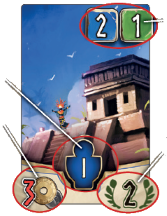
|
Points
You score this many points
during final scoring for
having this card.
You score 2 points from this card.
|
|
Phase A
Phase A follow these steps:
First player in Epoch I is the player with lowest initiative value on their setup card.
In Epoch II it's second lowest, in Epoch III third lowest (2p games: lowest again).
In 4 or 5 player games, all other players get 1 coin at the beginning of Epoch I,
in 2 player games: the one who is start player only once.
The first player sets the wheel.
Draw 2 facedown cards and buy or sell a card (for each colour)
All players resolve this step simultaneously.
On Yucata this is simulated by resolving this step only after all players have made their choices.
Draw 2 cards from the deck your player icon is pointing at, discard one of it
faceup on the corresponding discard pile, and decide whether you buy (2a) or sell (2b)
the remaining one.
You cannot choose to discard both cards, buy both cards, or sell both cards.
(1) Discard 1 card to the discard pile
Place 1 of the 2 cards faceup in the discard pile of the
corresponding color.
(2a) Buy 1 card 
You can buy a card by paying its cost in coins, returning the coins to the
supply. The cost to buy a card is reduced based on the number of cards of
its color you already have.
Most cards have values that add to one or more of your
tracks. Purple cards can have effects instead,
see here
for an overview of these.
(2b) Sell 1 card 
You can choose to sell a card instead of buying it. Cards that are sold are out of the game
and you gain coins depending on the Epoch( I: 2, II: 3, III: 4)
Turn the Wheel
After each player has drawn from the deck their icon
is pointing at, rotate the wheel clockwise so that each
player icon is pointing at the next clockwise deck. Each
player draws 2 more cards from the new deck their
icon points at and chooses 1 to discard and 1 to buy
or sell. Repeat until each player has visited each colour this way.
Phase A
Phase A follow these steps:
Determine the first player and set the wheel 
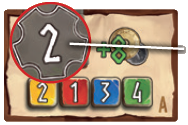
Initiative
During epoch I, the player with the lowest-value initiative on their setup card
is the first player. During epoch II, the player with the second-lowest initiative
on their setup card is the first player. During epoch III, the player with the
thirdlowest
initiative
on their setup card is the first player. At the beginning of epoch
I, give 1 coin from the supply to each player who will not be the first player at
any point during the game.
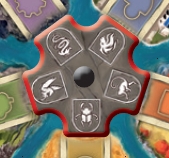 Example
Example: You set the wheel such that each player icon points to a deck.
This is possible only in a 4 or 5-player game.
2-player Game: During a 2-player game, the player with the lowest
initiative will be the first player during epochs I and III. Give the other player
1 coin at the beginning of epoch I.
The first player sets the wheel on the board such that
each player icon
points to a deck.
All players resolve this step simultaneously.
On Yucata this is simulated by resolving this step only after all players have made their choices.
Draw 2 cards from the deck your player icon is
pointing at.
Next, choose 1 of the 2 cards and place it faceup in the discard pile of the deck you drew it from (1). Finally, you
can either buy (2a) or sell (2b) the remaining card.
You cannot choose to discard both cards, buy both cards, or sell both cards.
(1) Discard 1 card to the discard pile
Place 1 of the 2 cards faceup in the discard pile of the
corresponding color.
(2a) Buy 1 card 
You can buy a card by paying its cost in coins, returning the coins to the
supply. The cost to buy a card is reduced based on the number of cards of
its color you already have. See “Reducing the cost of cards” below.
Once you have paid for a card, place it below your player board under the
corresponding color. Place cards of the same color on top of each other such that you
can see the values on each of them.
Most cards have values that add to one or more of your
tracks. When you buy a card, move the markers on your
tracks up based on the value(s) on the card.
You can check the values on your cards and tiles at any
time to ensure that your markers are correct.
Purple cards can have either values or effects. If the card you bought has an effect, then that effect
becomes available for you to use as soon as you buy it. See here a
summary of the purple card effects
.
Tracking values past 10

If one of your tracks would increase past 10, add
a 10-value marker from the supply to the
end of the corresponding track, then continue
tracking the value from 1.
The cost to buy a card is reduced by 1 for each card of that color
you already have, to a minimum of 0.
(2b) Sell 1 card 
You can choose to sell a card instead of buying it. To sell a card, place it facedown in a pile next to the board
(not in the color discard piles). Cards that are sold are out of the game. Then, you gain coins from the supply
as indicated on the back of the card:
-
Epoch I: 2 coins
-
Epoch II: 3 coins
-
Epoch III: 4 coins
Turn the Wheel
After each player has drawn from the deck their icon
is pointing at, rotate the wheel clockwise so that each
player icon is pointing at the next clockwise deck. Each
player draws 2 more cards from the new deck their
icon points at and chooses 1 to discard and 1 to buy
or sell.
Continue turning the wheel and drawing cards
until there are no facedown cards left on the board. In
this way, during each phase A of the game, each player
draws 2 cards from each deck each epoch.
After the end of phase A, players resolve the following steps in order:
Each player gains coins from the supply equal to their income track value.
Starting with the first player and continuing clockwise, each player can take 1 colony that they fulfill the
requirement for, either by plundering it or by integrating it. To fulfill a colony’s requirement, the value on
your military track must be equal to or greater than the value in the bottom-left corner of the colony.
You never lose a colony, even if your military track is reduced below the requirement (see “Feed Your People”).
-
You can take only 1 colony during each “Take a Colony” step.
-
You can take only 1 colony for each requirement level (
 ). ).
-
You can take colonies in any order, as long as you fulfill the requirements.
Plundering and Integrating
When you take a colony, place it to the left of your player board without looking at its reverse side. Then choose to
either plunder or integrate the colony.



If you plunder the colony, you gain the number of coins shown in green, and do
not flip the colony over. If you integrate the colony, you instead pay the number
of coins shown in red and flip the colony over, increasing your tracks based on the
values on the reverse side.
You cannot look at the back of a colony before flipping it, and you cannot reverse your decision to
plunder or integrate a colony.
Starting with the first player and continuing clockwise, each player can carve 1 statue
that they fulfill the requirement for.
When you carve a statue, place 1 of your unused bonus
tiles on your player board on the space corresponding
to the statue that you just carved. You choose to either
place the tile faceup, showing one of the four tracks ( , ,
 , ,
 or
or  ), or facedown showing points ( ), or facedown showing points ( ). ).
You gain a bonus based on how you place the tile:
Faceup: You increase the corresponding track by the
value indicated to the left of the bonus tile space.
Facedown: During final scoring, you score points equal
to the value indicated to the left of the bonus tile space,
in addition to the points from the statue itself.
You never lose a statue, even if your culture track is
reduced below the requirement (see “Feed Your People”).
-
You can carve only 1 statue during each “Carve a Statue” step.
-
You can carve each statue only once.
-
You can carve statues in any order, as long as you fulfill the requirements.
-
You cannot move or flip bonus tiles on carved statues.
After carving statues, phase A ends and phase B begins.
Phase B
Starting with the first player and continuing clockwise,
each player takes 1 faceup card from the
top of
a discard pile
. The position of the wheel does not
matter during phase B; you can take a card from any
pile. You can take only the top card of a discard pile,
and you cannot look through the discard piles.
As during phase A when drawing cards, choose to either buy or sell the card you took. You cannot choose to discard
cards during phase B. See pages 5-6 for details on buying and selling cards.
Players take turns taking cards and buying or selling them until there are no cards left on the board.
After taking faceup cards, resolve the following 3 steps, as after phase A. Then
continue to Feed Your People and Buy Silver and Gold Medals.
Income

Take a Colony

Carve a statue

Each card you have increases your food requirement by 1. Count up all of your cards (not including your setup
card) and compare the total to the value on your food track.

If the value of your food track  is equal to or greater than your card
total, your people are fed and nothing happens.
is equal to or greater than your card
total, your people are fed and nothing happens.
 If the value of your food track
If the value of your food track  is
lower than your card total, you must
choose and remove cards until the total
is equal to the value of your food track.
Place cards removed this way in the facedown
pile next to the board, out of play. is
lower than your card total, you must
choose and remove cards until the total
is equal to the value of your food track.
Place cards removed this way in the facedown
pile next to the board, out of play.

When you remove a card, you must also
reduce your tracks by all values shown
on the card you remove. If you remove a
card with an effect, you also immediately
lose
that effect
.
When removing cards, you
do not
gain coins
as you would when selling cards.
Note: If you remove a card with a food value, you use
the new, reduced food track value to determine the number of cards you must remove. Thus, it is not beneficial to
remove cards with food values.
There are 2 different types of medals. Silver medals are represented by placing
bonus tiles, while gold medals are represented by gold medal tokens.
-
 Silver medals: Points for specific track values.
Silver medals: Points for specific track values.
-
 Gold medals: Points for sets of all 5 colors.
Gold medals: Points for sets of all 5 colors.
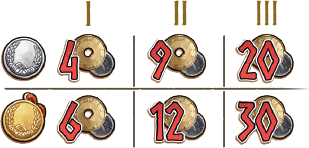 During this step, players can buy medals. The reference sheet shows how many coins you must
pay to buy a medal, based on the current epoch. You can buy up to a maximum of 2 silver and
2 gold medals during the game, and you can buy any number of each (up to the maximum)
during each “Buy Silver or Gold Medals” step.
During this step, players can buy medals. The reference sheet shows how many coins you must
pay to buy a medal, based on the current epoch. You can buy up to a maximum of 2 silver and
2 gold medals during the game, and you can buy any number of each (up to the maximum)
during each “Buy Silver or Gold Medals” step.
 Silver medals: Silver medals:
When you buy a silver medal, place 1 of your unused
bonus tiles ( , ,
 , ,
 or
or  )
onto an empty silver
medal space on your player board. During final scoring,
you score points equal to
half your value on the
corresponding track
(rounded up). )
onto an empty silver
medal space on your player board. During final scoring,
you score points equal to
half your value on the
corresponding track
(rounded up).
 Gold medals: Gold medals:
When you buy a gold medal, place one of your setaside
gold medals onto one of the empty gold medal
spaces on your player board. During final scoring,
you score
7 points per set of 5 differently-colored
cards
you have. If you bought 2 gold medals, you
score 14 points per set.
A new Epoch
After epoch I, the game continues with epoch II, and ends after epoch III.
At the start of each successive epoch (after epoch I is concluded), take
the corresponding set-aside epoch cards and divide them into decks
by color. Then, place 2 cards of each color per player facedown on the
corresponding inner spaces of the board, returning all other cards from
that epoch to the box.
Epochs II and III are then played exactly the same as epoch I.
For the basic game, remove the epoch II and III purple cards with stars , as
during epoch I.
After the end of epoch III, the game ends, and players resolve final scoring.
Purple Card Effect Summary
When you buy a purple card with an effect, you immediately gain the shown
effect. You can use that effect as long as you have that card.
(Cards with a star are advanced cards.)
Epoch I: Basic Game
Whenever you sell a card, gain
1 additional coin.
Immediately place 1 of your bonus tiles (  ,
 ,
 ,  )
face-up on this card, then immediately increase the corresponding track by 2.
If you remove this card, you must reduce the track value by 2, but you regain the bonus tile.
Epoch I: Advanced Game
Immediately increase the Culture track by 1 for each Blue card you have (  ). Whenever you buy
another Blue card, you increase the Culture track by 1.
Immediately increase the Income track by 1 for each Yellow card you have (  ). Whenever you buy
another Yellow card, you increase the Income track by 1.
Immediately increase the Food track by 1 for each Green card you have (  ). Whenever you buy
another Green card, you increase the Food track by 1.
Immediately increase the Military track by 1 for each Red card you have (  ). Whenever you buy
another Red card, you increase the Military track by 1.
Epoch II: Basic Game
Whenever you take a colony, you gain 4
additional coins.
The costs of silver  and gold 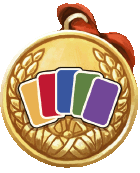 medals
during epoch II and III are reduced to the amounts shown.
Epoch II: Advanced Game
When you receive income, you
gain 2
coins for each other track
(  ,
 ,  )
with a value greater than the value of your
income track  .
When feeding your people, if your food
track value is higher than your card total,
you
gain coins equal to the difference
times 3
, up to a maximum of 12 coins
total per phase.
If, when feeding your people, you would
have to remove cards, you can instead pay 2 coins per card you would have to
remove, up to a maximum of 6 times each time you feed your people.
Example: Your food track value is 9 and you have 11 cards.
Instead of removing 2 cards, you pay 4 coins. You could instead
pay 2 coins and remove 1 card.
Epoch III: Basic Game
1 of your purchased silver medals is worth
points equal to the full value of the
corresponding track
, instead of half.
During final scoring,
score 4 points per
set of 5 differently-colored cards
in
addition to any points from gold medals.
Epoch III: Advanced Game
The requirements to take colonies or carve
statues are reduced by 4 for you.
This card counts as
1 card of any color
for 1 set
for the purpose of gold medal 
scoring only.
During each “Take a Colony” and “Car ve
a Statue” step, you can
resolve the
corresponding action twice
, if you fulfill t he
necessary requirements.
If you do not fulfill the requirement to take a
colony or carve a statue, you can
pay coins
to reduce the requirement
by 1 for every 3
coins you spend. You can spend a maximum of
30 coins this way each phase.
Example: Your military track value  is 14, and you want to
take a colony is 14, and you want to
take a colony  . You pay 3 coins to reduce the requirement to
14 and take the colony. . You pay 3 coins to reduce the requirement to
14 and take the colony.
Epoch Summary
Phase A

Determine first player and set wheel

Draw 2 facedown cards from decks
(until there are no cards left in decks)

Income

Take 1 colony (plunder or integrate)

Carve 1 statue
Phase B

Take turns taking 1 faceup card from discard
(until there are no cards left on the board)

Income

Take 1 colony (plunder or integrate)

Carve 1 statue

Feed your people (1 food per card)

Buy silver and gold medals
(up to 2 of each medal per phase)
Simulation of simultanous play in Phase A
The card phase A is played simultaneous. The cards discarded and the ones kept for buying/selling will be processed after each player has made their choice.
The players themselves can preview the effects on resources, coins and points indicated between parentheses.
The card which you bought or sold remains visible next to the main board until its processed.
Points display
The points include those from Cards, Colonies and Statues.
The number in parenthesis behind the points of a player indicate the total 'value' as if the game would be ended in this moment;
including points for Silver & Gold medals and points for remaining Coins.
View discard piles
You can see which cards were discarded - face up on the main board - by clicking on the indicator showing how many cards there are in the deck.
View purple card description
While the magnified view is already a popup by itself, it is not possible to click on a card to magnify it again or see a description.
You can read a description of purple cards with a special effect
- in tab view by clicking on the purple card
- in grid view by clicking on the special effect
| |